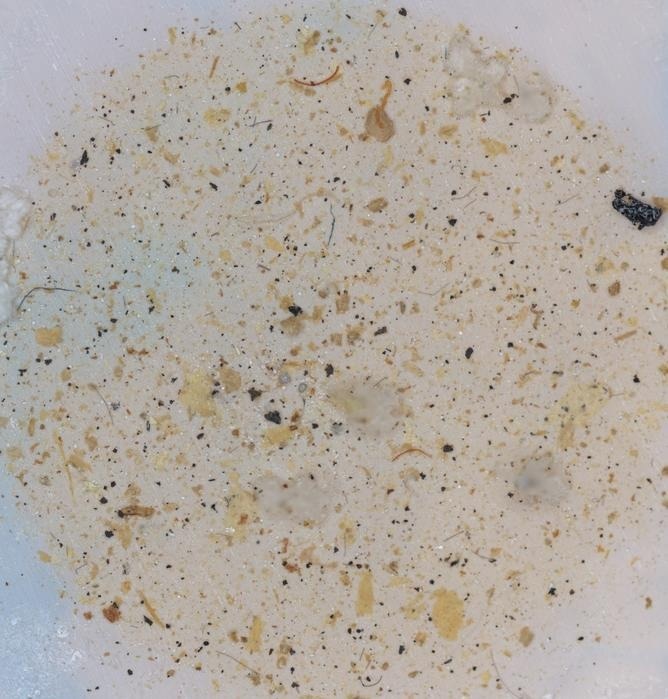Modern farming, like any other industry, is heavily reliant on plastics. To name a few examples, consider plastic mulch lining vegetable beds, PVC pipes draining water from fields, polyethylene covering high tunnels, and plastic seed, fertilizer, and herbicide packaging.
 Microplastic fragments like these, isolated from farm soil in Illinois, may provide pathogenic bacteria the perfect substrate to develop antibiotic resistance and transfer related genes to neighboring bacteria. A new University of Illinois review paper calls for greater study to clarify the interaction between microplastics and microbes where our food is grown. Image Credit: Jayita De and Pratik Banerjee, University of Illinois
Microplastic fragments like these, isolated from farm soil in Illinois, may provide pathogenic bacteria the perfect substrate to develop antibiotic resistance and transfer related genes to neighboring bacteria. A new University of Illinois review paper calls for greater study to clarify the interaction between microplastics and microbes where our food is grown. Image Credit: Jayita De and Pratik Banerjee, University of Illinois
According to a new review article published by University of Illinois Urbana-Champaign scientists, these plastics are now distributed widely in agricultural soils as microplastics and nanoplastics.
Microplastics have been discovered in nearly every ecosystem and organism on the planet. The twist, according to investigators at the College of Agricultural, Consumer, and Environmental Sciences (ACES), is that micro- and nanoplastics in agricultural soil may contribute to antibiotic-resistant bacteria with an easy path into human food supply.
Plastic itself may not be very toxic, but it can act as a vector for transmitting pathogenic and antimicrobial resistant bacteria into the food chain. This phenomenon is not very well known to people, so we wanted to raise awareness.
Jayashree Nath, Study Author and Postdoctoral Researcher, Department of Food Science and Human Nutrition, College of Agricultural, Consumer, and Environmental Sciences
If the link between microplastics and antibiotic resistance is not obvious, here is how it works. For starters, plastics are excellent adsorbents. This means that chemical substances and microscopic organisms are drawn to plastic.
Pesticides and heavy metals, for example, that would normally move quickly through soil, stick around and become concentrated when they come into contact with plastics. Similarly, bacteria and other microbes that naturally occur in soil congregate on the stable surfaces of microplastics, forming biofilms.
When bacteria come into contact with unusual chemical substances in their new home, they stimulate stress response genes, which help them resist other chemicals, including antibiotics. When groups of bacteria adhere to the same surface, they have a tendency to share these genes via a process known as horizontal gene transfer. Nanoplastics, which can enter bacterial cells, cause a different type of stress, but the result can be the same.
Bacteria have been evolving genetic mechanisms to cope with stress for millions of years. Plastic is a new material bacteria have never seen in nature, so they are now evoking these genetic tool sets to deal with that stress. We have also shown bacteria may become more virulent in the presence of plastics, in addition to becoming more resistant to antimicrobials.
Pratik Banerjee, Study Co-Author and Associate Professor, Food Science and Human Nutrition, University of Illinois at Urbana-Champaign
Pratik Banerjee is also an Illinois Extension specialist.
Other environments, particularly water, have shown evidence of gene transfer between bacteria and microplastics. So far, the phenomenon in agricultural soil is only hypothetical, but that does not mean it does not exist. Currently, Nath and Banerjee are conducting laboratory studies to record gene transfer.
Soil is an under-researched area in this field. We have an obligation to understand what's going on in soil because what we suspect and what we fear is that the situation in soil could be even worse than in water.
Pratik Banerjee, Study Co-Author and Associate Professor, Food Science and Human Nutrition, University of Illinois at Urbana-Champaign
Pratik Banerjee adds, “One of the technical problems is that soil is a very difficult medium to handle when it comes to fishing out microplastics. Water is so easy because you can simply filter the microplastic out. But we have made some good headway thanks to Jayashree and our collaboration with the Illinois Sustainable Technology Center.”
However, nanoplastics and bacteria that are resistant to antibiotics may be small enough to enter roots and plant tissues, where they are difficult to wash away. According to the authors, many foodborne pathogens make their way onto produce from their native home in the soil. Although nanoplastics have been discovered in and on crops, the frequency of this is unknown because the field of study is still in its early stages. The study team led by Banerjee plans to address this issue as well.
Microplastics will likely never go away. They sustain in the environment for hundreds of years or more. The authors argue that it is time to educate people about these effects on the soil and the food system and to promote the use of biodegradable plastics in their place.
Source:
Journal reference:
Nath, J., et al. (2023). Interaction of Microbes with Microplastics and Nanoplastics in the Agroecosystems—Impact on Antimicrobial Resistance. Pathogens. doi.org/10.3390/pathogens12070888.